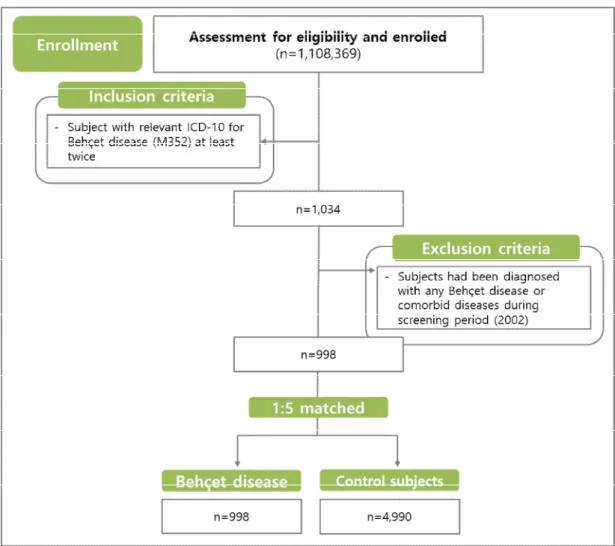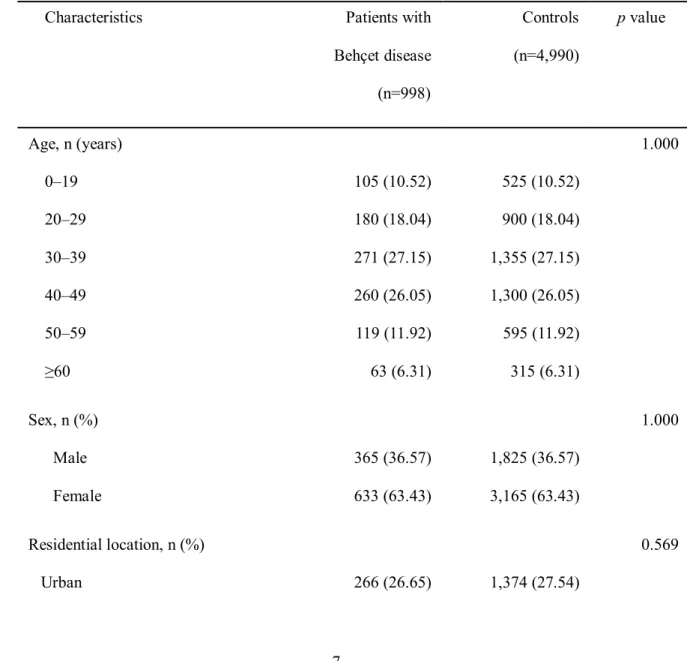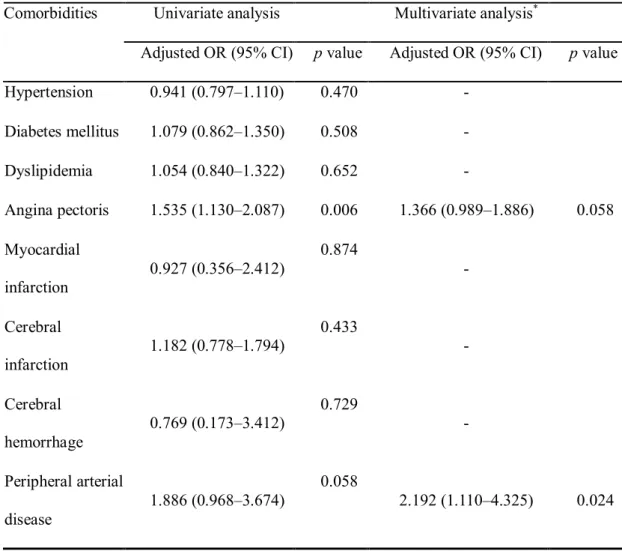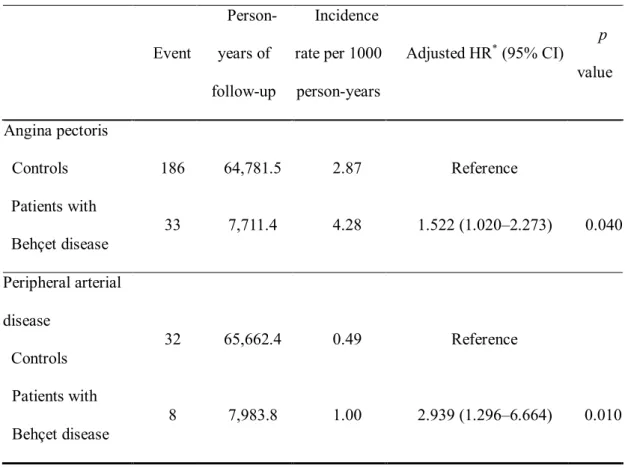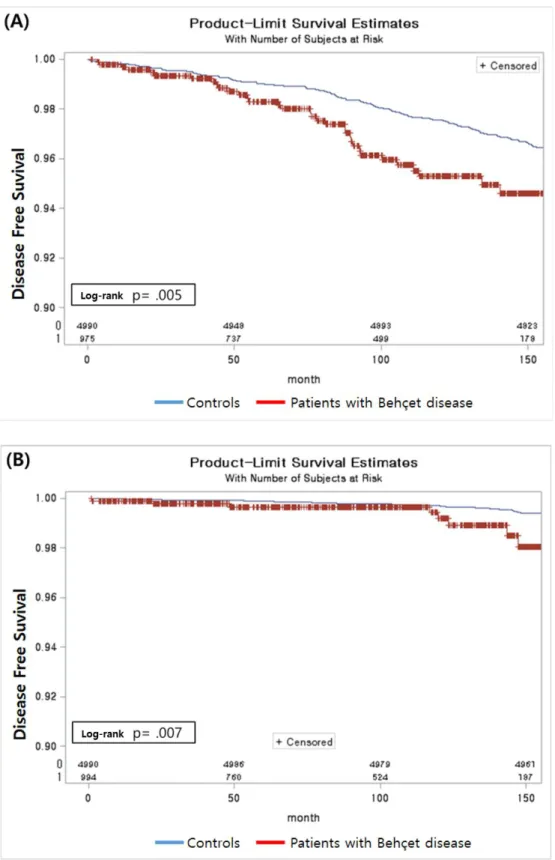저작자표시-비영리-변경금지 2.0 대한민국 이용자는 아래의 조건을 따르는 경우에 한하여 자유롭게
l 이 저작물을 복제, 배포, 전송, 전시, 공연 및 방송할 수 있습니다. 다음과 같은 조건을 따라야 합니다:
l 귀하는, 이 저작물의 재이용이나 배포의 경우, 이 저작물에 적용된 이용허락조건 을 명확하게 나타내어야 합니다.
l 저작권자로부터 별도의 허가를 받으면 이러한 조건들은 적용되지 않습니다.
저작권법에 따른 이용자의 권리는 위의 내용에 의하여 영향을 받지 않습니다. 이것은 이용허락규약(Legal Code)을 이해하기 쉽게 요약한 것입니다.
Disclaimer
저작자표시. 귀하는 원저작자를 표시하여야 합니다.
비영리. 귀하는 이 저작물을 영리 목적으로 이용할 수 없습니다.
변경금지. 귀하는 이 저작물을 개작, 변형 또는 가공할 수 없습니다.
의학박사 학위논문
베체트 병 환자에서 심혈관계 질환의 위험성 : 전국민 기반 표본 코호트의 후향적 분석
Risk of cardiovascular disease in patients with Behçet disease:
Retrospective analysis of the nationwide population-based cohort
울 산 대 학 교 대 학 원 의 학 과
권 준 교
[UCI]I804:48009-200000171043 [UCI]I804:48009-200000171043 [UCI]I804:48009-200000171043
베체트 병 환자에서 심혈관계 질환의 위험성 : 전국민 기반 표본 코호트의 후향적 분석
지 도 교 수 권 태 원
이 논문을 의학박사 학위 논문으로 제출함
2018 년 12 월
울 산 대 학 교 대 학 원 의 학 과
권 준 교
권준교의 의학박사학위 논문을 인준함
심사위원 권태원 인 심사위원 고기영 인 심사위원 박상준 인 심사위원 정철웅 인 심사위원 신 성 인
울 산 대 학 교 대 학 원
2018 년 12 월
Abstract
Few studies have investigated the correlation between Behçet disease (BD) and
cardiovascular diseases (CVD). We investigated the risk of CVD in patients with BD.
Between 2003 and 2015, we performed a retrospective cohort study involving patients with
BD selected from the National Health Insurance Service-National Sample Cohort database
and age- and sex-matched controls. Logistic regression analysis was performed to examine
the association between BD and comorbidities. Cox proportional hazards regression analysis
was performed to compare the hazard ratio (HR) of diseases that showed significance using
logistic regression analysis. Among the 998 patients with BD and the 4,990 controls studied,
patients with BD showed a significantly higher risk for angina pectoris (adjusted HR 1.522,
95% confidence interval [CI] 1.020–2.273) and peripheral arterial disease (adjusted HR
2.939, 95% CI 1.296–6.664) than controls. The cumulative incidence rates of these diseases
in patients with BD were also significantly higher than those in controls (log-rank p=0.005
and 0.007 for angina pectoris and peripheral arterial disease, respectively). This study
demonstrated that patients with BD showed an independent risk for angina pectoris and
peripheral arterial disease.
Contents
Abstract··· i
List of tables & figures··· v
Introduction··· 1
Materials and methods ··· 2
Study design and database ··· 2
Definition of clinical outcomes ··· 3
Statistical analysis··· 5
Results ··· 6
Baseline and clinical characteristics of patients with Behçet disease and controls ··· 6
Association between Behçet disease and comorbidities ··· 6
Incidence of cardiovascular disease in patients with Behçet disease··· 10
Discussion··· 13
Conclusion ··· 16
References ··· 16
Korean Abstract ··· 20
List of Tables
Table 1 ··· 7
Table 2 ··· 9
Table 3 ··· 11
List of Figures
Figure 1··· 4
Figure 2··· 12
Introduction
Behçet disease (BD) shows a global distribution; however, it is particularly prevalent in the
Middle East and the Far East along the Silk Road.1This could be attributed to genetic factors,
such as the association of BD with HLA-51.2 BD is considered a systemic vasculitis
presenting with diverse clinical symptoms involving the skin and the mucous membranes, as
well as ocular, arthritic, and vascular signs.3, 4 However, vascular involvement observed in
patients with BD is nonspecific, unlike other symptoms. The association of HLA-51 with
vascular manifestations is not linked,5 and vascular manifestations were included in the
diagnostic criteria for BD only after 2014.6 However, vascular involvement is known to
occur and its incidence varies from 7%–50%.7, 8 A few studies have investigated the
relationship between cardiac lesions and BD in relation to vascular involvement.9, 10
However, no study has established to quantitatively analyze the risk for cardiovascular
diseases (CVD) in BD. We performed a Korean population-based cohort study using the
National Health Insurance Service–National Sample Cohort (NHIS-NSC) database to
investigate the risk of CVD in patients with BD.
Materials and methods
Study design and database
This was a retrospective cohort study that investigated records of 1,108,369 representative
patients obtained from the NHIS-NSC database. Of note, 100% of the Korean population is
covered by the NHIS, and this population is classified into 3 categories: The NHI program
for employees, for the self-employed groups, and the medical aid system. In 2013, 97.2%
(n=49,989,620) of the population was covered by the NHI and the remaining 2.8%
(n=1,458,871) by the medical aid system.11 Owing to the large volume of the database and
the lack of confidentiality in regards to personal information available with the National
Health Information Database (NHID), the NHIS-NSC was modeled as a representative
sample database, which contains a substantial volume of representative information that does
not require privacy regulations.12 We obtained information from the NHIS-NSC database
between January 2002 and December 2015 for our study. Patients who had been treated for
any type of BD or comorbidities during the screening period (2002) were excluded. Age, sex,
residential location, income, and diagnostic codes based on the International Classification of
Diseases, Tenth Revision (ICD-10) were recorded. This study was approved by the Ethics
Committee of Korea University Anam Hospital (2018AN0009) and was performed
according to the principles of the Declaration of Helsinki. The flow chart of the study is
summarized in Figure 1.
Definition of clinical outcomes
Patients with ICD-10 codes M352 (BD) were identified from the NHIS-NSC. BD is
diagnosed by the national registry of rare intractable disease program in NHIS-NSC. To be
diagnosed in the rare intractable disease registration, the diagnosis must be suitable for
specific diagnostic criteria defined by the Korean health ministry. Patients with
comorbidities were defined as those with hypertension (ICD-10 codes I10-13 and I15),
(ICD-10 codes I20), myocardial infarction (ICD-10 codes I21 and I22), cerebral infarction
(ICD-10 codes I63), cerebral hemorrhage (ICD-10 codes I60), or peripheral arterial disease
(PAD) (ICD-10 codes I70, I70.0, I70.2-70.3, I70.8-70.9, I74.2-74.5). To improve the
accuracy of the analysis, we only included patients with at least 2 principal diagnostic codes
Figure 1. Flowchart of the study
for each disease. The date of diagnosis of the diseases was used as the entry date for patients
with the disease. Age- and sex-matched controls were selected randomly from the NHIS-
NSC database at a frequency of 1:5.
Statistical analysis
The Pearson’s chi-squared test or the Fisher exact test was used to assess significant
differences between nominal variables. Logistic regression analysis was performed to
examine the association between BD and comorbidities including hypertension, diabetes
mellitus, dyslipidemia, angina pectoris, myocardial infarction, cerebral infarction, cerebral
hemorrhage, or PAD. Variables showing a p value <0.10 using the univariate model were
subjected to analysis using a multivariate model, followed by backward elimination to retain
the final significant predictors in the model. Incidence rates were calculated by dividing the
number of events by person-years at risk. Both, univariate and multivariate Cox proportional
hazards regression analyses were performed using α=0.05 as the significance level to
calculate the crude hazard ratio (HR) and the mutually adjusted HRs with their 95%
confidence intervals (CI) after adjusting for residential location, income, and comorbidities.
Survival curves of angina pectoris and PAD in patients with BD and in controls were plotted
rank test. A p value <0.05 was considered statistically significant. Data were analyzed using
the SAS software version 9.4 (SAS Institute, Cary, NC, USA).
Results
Baseline and clinical characteristics of patients with Behçet disease and controls
Between January 2003 and December 2015, we identified 998 patients with BD and 4,990
matched controls without BD (ratio 1:5). The sex ratio among patients with BD was
female:male=63.43:36.57. The highest prevalence of sleep disorders was observed among
patients aged 30–39 years (27.15%), followed by those aged 40–49 years (26.05%). In both
groups, the most prevalent comorbidity was hypertension, followed by diabetes mellitus.
Demographic and clinical characteristics of the study population are summarized in Table 1.
Association between Behçet disease and comorbidities
We performed univariate and multivariate logistic analyses to evaluate the association
between BD and comorbidities (Table 2). Univariate analysis showed a positive trend
between BD and PAD (odds ratio [OR] 1.886, 95% CI 0.968–3.674, p=0.058), and this trend
became significant after adjusting for variables (p=0.024). However, univariate analysis
showed a significant association between BD and angina pectoris (OR 1.535, 95% CI 1.130–
2.087, p=0.006), although the significance disappeared after adjusting for variables
(p=0.058). The association between BD and comorbidities other than angina pectoris and
PAD was not statistically significant compared to controls.
Table 1.Demographic and clinical characteristics of the study population
Characteristics Patients with
Behçet disease (n=998)
Controls (n=4,990)
pvalue
Age, n (years) 0–19 20–29 30–39 40–49 50–59
≥60
105 (10.52) 180 (18.04) 271 (27.15) 260 (26.05) 119 (11.92) 63 (6.31)
525 (10.52) 900 (18.04) 1,355 (27.15) 1,300 (26.05) 595 (11.92) 315 (6.31)
1.000
Sex, n (%) Male Female
365 (36.57) 633 (63.43)
1,825 (36.57) 3,165 (63.43)
1.000
Residential location, n (%) 0.569
Rural 732 (73.35) 3,616 (72.46)
Income, n (%) 0–20 20–40 40–60 60–80 80–100
111 (11.62) 132 (13.82) 223 (23.35) 245 (25.65) 244 (25.55)
674 (13.90) 785 (16.19) 1,124 (23.18) 1,119 (23.07) 1,148 (23.67)
0.005
Comorbidities Hypertension Diabetes mellitus Dyslipidemia Angina pectoris Myocardial infarction Cerebral infarction Cerebral hemorrhage Peripheral arterial disease
213 (21.34) 103 (10.32) 100 (10.07) 56 (5.61) 5 (0.50) 28 (2.81) 2 (0.20) 12 (1.20)
1,117 (22.38) 481 (9.64) 477 (9.56) 186 (3.73) 27 (0.54) 119 (2.38) 13 (0.26) 32 (0.64)
0.470 0.508 0.652 0.006 0.874 0.433 0.729 0.058
Table 2. Logistic regression analysis for comorbidities in patients with Behçet disease
compared to controls
Comorbidities Univariate analysis Multivariate analysis*
Adjusted OR (95% CI) pvalue Adjusted OR (95% CI) pvalue
Hypertension 0.941 (0.797–1.110) 0.470 -
Diabetes mellitus 1.079 (0.862–1.350) 0.508 -
Dyslipidemia 1.054 (0.840–1.322) 0.652 -
Angina pectoris 1.535 (1.130–2.087) 0.006 1.366 (0.989–1.886) 0.058 Myocardial
infarction
0.927 (0.356–2.412)
0.874
-
Cerebral infarction
1.182 (0.778–1.794) 0.433
-
Cerebral hemorrhage
0.769 (0.173–3.412)
0.729
-
Peripheral arterial disease
1.886 (0.968–3.674)
0.058
2.192 (1.110–4.325) 0.024
CI: confidence interval, OR: odds ratio
*Adjusted for residential location, income, and variables showing a pvalue <0.10 using
univariate analysis
Incidence of cardiovascular diseases in patients with Behçet disease
Based on the results of logistic analyses, we chose angina pectoris and PAD as the
comorbidities that could be affected by BD. In patients with BD and controls, the incidence
of angina pectoris was 4.28 and 2.87, and the incidence of PAD was 1.00 and 0.49 per 1000
person-years, respectively. Cox proportional hazards regression analysis showed that the risk
for angina pectoris (crude HR 1.693, 95% CI 1.163–2.465) and PAD (crude HR 2.868, 95%
CI 1.294–6.357) was significantly higher in patients with BD than in controls. This
significance was maintained even after adjusting for residential location, income, and
comorbidities (adjusted HR 1.522, 95% CI 1.020–2.273 for angina pectoris and adjusted HR
2.939, 95% CI 1.296–6.664 for PAD) (Table 3).
The Kaplan–Meier curves for angina pectoris and PAD between patients with BD and
controls are plotted in Figure 2. The cumulative incidence of angina pectoris (log-rank
p=0.005) and PAD (log-rank p=0.007) was significantly higher in patients with BD than in
controls.
Table 3. Incidence rates of angina pectoris and peripheral arterial disease per 1000 person-
years in patients with Behçet disease compared to controls
Event
Person- years of follow-up
Incidence rate per 1000 person-years
Adjusted HR*(95% CI) p value
Angina pectoris
Controls 186 64,781.5 2.87 Reference
Patients with Behçet disease
33 7,711.4 4.28 1.522 (1.020–2.273) 0.040
Peripheral arterial disease
Controls
32 65,662.4 0.49 Reference
Patients with Behçet disease
8 7,983.8 1.00 2.939 (1.296–6.664) 0.010
CI: confidence interval, HR: hazard ratio
*Adjusted for residential location, income, and comorbidities
Figure 2. Kaplan-Meier estimate plotted to show the survival probabilities of angina pectoris (A) and peripheral arterial disease (B) in patients with Behçet disease and controls between 2003 and 2015.
Discussion
We performed a retrospective cohort study between 2003 and 2015 in 998 patients with BD
and 4,990 controls to investigate the risk of CVD in patients with BD. This study highlighted
important findings. Among various comorbidities, patients with BD showed a significantly
higher risk for angina pectoris and PAD than controls. The cumulative incidence of these
diseases in patients with BD was also significantly higher than that in controls. This result
was observed after adjusting for age, sex, risk factors of CVD, income, and residential
location with the control group.
A complex interplay between endothelial dysfunction, coagulopathy, inflammatory, and
immunological reactions leads to arterial atherosclerosis, which is the cause of CVD, 13 and
these factors work synergistically to induce atherosclerosis. These same factors contribute to
atherosclerosis in patients with BD. High levels of selectins, intercellular adhesion molecule-
1, vascular cell adhesion molecule-1, and matrix metalloproteinases observed in patients
with BD are known to trigger endothelial activation.14 Although the exact cause of a
hypercoagulable state in patients with BD remains unclear, thrombotic occlusion of vessels
is attributed to platelet dysfunction and excessively high levels of plasma coagulation factors.
This procoagulant tendency also explains the vascular involvement observed in patients with
BD. 8 Based on the aforementioned observations and facts, it is theoretically reasonable to
conclude that BD is a risk factor for PAD and angina.
In a study assessing the risk factors of CVD, Kayatas et al. reported that patients with BD
show lower serum levels of low density lipoprotein than controls.15Our study did not show
an intergroup difference in prevalence rates of dyslipidemia.
Arterial lesions were reported in 1.0–7.0% of patients with BD.16, 17 A previous
retrospective cohort study involving 412 patients with BD reported that 26 patients showed
large-vessel involvement.18 Another cross-sectional study reported by Ugurlu et al. showed
that intermittent claudication was significantly more common in patients with BD. 19In this
study, patients with BD showed a significantly higher risk for PAD than controls. Vascular
involvement is a potentially life-threatening condition because arterial lesions observed in
patients with BD include aneurysms of large vessels and peripheral arterial occlusion. 16
Although vascular involvement is known to occur in patients with BD, the association
between BD and coronary heart disease including angina pectoris and myocardial infarction
remains unclear. Our analysis showed that patients with BD demonstrated a significantly
higher risk of angina pectoris than that in controls over 13-year follow-up. However, the
previous study reported by Ugurlu et al. showed that the prevalence of angina pectoris,
myocardial infarction, and other forms of coronary heart disease did not significantly differ
between patients with BD and non-BD controls.19 This discrepancy in results is attributable
to differences in study design. Another interesting result is that income levels in patients with
BD were higher than those in controls. Other studies have shown similar results in that
socioeconomic status was higher in the BD than in the control group.10 This result is
attributable to the fact that patients belonging to the higher socioeconomic strata of society
are more likely to visit a hospital more frequently and receive more frequent medical care.
Limitations of our study: 1) Smoking is a well-known risk factor for CVD; however, this
factor was not analyzed in our study. Smoking is a typical risk factor and should ideally be
because these conditions were diagnosed based on the NHIS claims database without
reviewing the detailed clinical charts. However, in Korea, the benefit extension policy is
applied to all patients with BD; thus, it is reasonable to assume a high accuracy in the
diagnosis of BD using the database. This is the first study to report the association between
BD and CVD using the population-based NHIS-NSC database.
Conclusion
This retrospective cohort study demonstrated that patients with BD show a significantly
higher risk of angina pectoris and PAD than controls. The strength of this study was its
longitudinal design with a 13-year follow-up period.
References
1. Ramos-Casals M, Brito-Zeron P, Kostov B, et al. Google-driven search
for big data in autoimmune geoepidemiology: analysis of 394,827 patients with
systemic autoimmune diseases. Autoimmun Rev 2015;14:670-9.
2. Mat MC, Sevim A, Fresko I, et al. Behcet's disease as a systemic disease.
Clin Dermatol 2014;32:435-42.
3. Sakane T, Takeno M, Suzuki N, et al. Current concepts - Behcet's disease.
N Engl J Med 1999;341:1284-91.
4. Kwon TW, Park SJ, Kim HK, et al. Surgical treatment result of abdominal
aortic aneurysm in Behcet's disease. Eur J Vasc Endovasc Surg 2008;35:173-80.
5. Maldini C, Lavalley MP, Cheminant M, et al. Relationships of HLA-B51
or B5 genotype with Behcet's disease clinical characteristics: systematic review and
meta-analyses of observational studies. Rheumatology (Oxford) 2012;51:887-900.
6. International Team for the Revision of the International Criteria for
Behçet's Disease (ITR-ICBD), Davatchi F, Assaad-Khalil S, et al. The International
Criteria for Behcet's Disease (ICBD): a collaborative study of 27 countries on the
sensitivity and specificity of the new criteria. J Eur Acad Dermatol Venereol
2014;28:338-47.
involvement in Behcet's disease. Scand J Rheumatol 2006;35:65-8.
8. Akar S, Ozcan MA, Ates H, et al. Circulated activated platelets and
increased platelet reactivity in patients with Behcet's disease. Clin Appl Thromb
Hemost 2006;12:451-7.
9. Geri G, Wechsler B, Thi Huong du L, et al. Spectrum of cardiac lesions in
Behcet disease: a series of 52 patients and review of the literature. Medicine
(Baltimore) 2012;91:25-34.
10. Yavne Y, Tiosano S, Watad A, et al. Investigating the link between
ischemic heart disease and Behcet's disease: A cross-sectional analysis. Int J Cardiol
2017;241:41-5.
11. Song SO, Jung CH, Song YD, et al. Background and data configuration
process of a nationwide population-based study using the korean national health
insurance system. Diabetes Metab J 2014;38:395-403.
12. Lee J, Lee JS, Park SH, et al. Cohort Profile: The National Health
Insurance Service-National Sample Cohort (NHIS-NSC), South Korea. Int J
Epidemiol 2017;46:e15.
13. Geovanini GR, Libby P. Atherosclerosis and inflammation: overview
and updates. Clin Sci (Lond) 2018;132:1243-52.
14. Fernandez-Bello I, Lopez-Longo FJ, Arias-Salgado EG, et al. Behcet's
disease: new insight into the relationship between procoagulant state, endothelial
activation/damage and disease activity. Orphanet J Rare Dis 2013;8:81.
15. Kayatas K, Karatoprak C, Cebeci F, et al. Presence of low lipid levels in
patients with Behcet' s disease as a protector against atherosclerosis. Eur Rev Med
Pharmacol Sci 2013;17:2330-4.
16. Yang SS, Park KM, Park YJ, et al. Peripheral arterial involvement in
Behcet's disease: an analysis of the results from a Korean referral center. Rheumatol
Int 2013;33:2101-8.
17. Sarica-Kucukoglu R, Akdag-Kose A, Kayabal IM, et al. Vascular
involvement in Behcet's disease: a retrospective analysis of 2319 cases. Int J
18. Ideguchi H, Suda A, Takeno M, et al. Characteristics of vascular
involvement in Behcet's disease in Japan: a retrospective cohort study. Clin Exp
Rheumatol 2011;29:S47-53.
19. Ugurlu S, Seyahi E, Yazici H. Prevalence of angina, myocardial
infarction and intermittent claudication assessed by Rose Questionnaire among
patients with Behcet's syndrome. Rheumatology (Oxford) 2008;47:472-5.
국문 요약
베체트 병은 혈관의 병적인 변화로 발생하는 질환으로 알려져 있으나, 아직 베체트 병에서 심혈관 질환의 위험도가 어느정도 인지 구체적으로 조사한 연구 는 없다. 우리는 전국민 건강 보험 서비스 데이터 베이스에서 추출한 표본 집단 데이터를 사용하여 이를 확인하고자 하였다. 연구는 데이터 베이스에서 확인한 베체트 병 환자와, 연령 및 성별, 지역, 소득 수준 등을 맞춰서 선정한 대조군 을 후향적으로 비교 분석하는 방식으로 진행되었다. 베체트 병 환자와 심혈관 질환들 사이의 연관성을 조사하기 위해 로지스틱 회귀 분석이 수행되었다. 분석 결과 유의성을 나타내는 심혈관 질환들은 위험비를 비교하기 위해 Cox 비례 위 험 회귀 분석을 실시 하였다. 위의 분석 결과, 베체트 병을 가진 998 명의 환자 와 선정된 4,990 명의 대조군에서 협심증 (보정된 위험비 1.522, 95% 신뢰 구간 1.020-2.273) 및 말초 동맥 질환 (보정된 위험비 2.939, 95% 신뢰 구간 1.296- 6.664)이 베체트 병 환자에서 발생 위험이 높은 것으로 나타났다. 누적 발병율
역시 대조군에 비해 유의하게 높았다 (협심증 및 말초 동맥 질환에 대한 log- rank p = 0.005 및 0.007). 결론적으로 이 연구를 통해서 베체트 병이 협심증 및 말초 동맥 질환의 독립적인 위험 인자임을 확인하였다.
